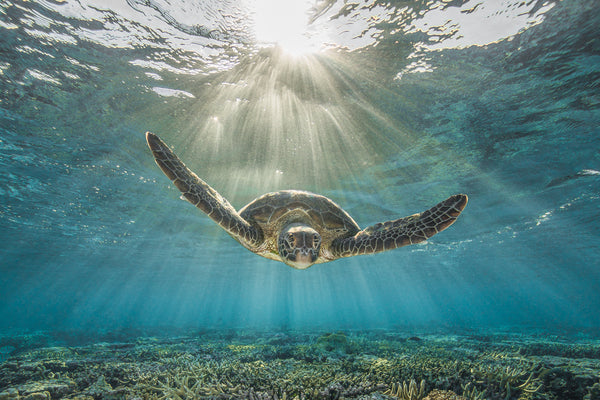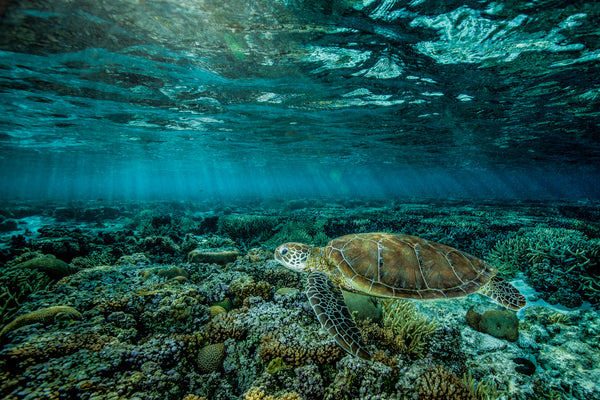A Guide to Marine Life Encounters While Diving
If you dream of swimming with sea turtles or are planning to snorkel on the Great Barrier Reef, I thought I’d share this with you. It’s my guide to marine life encounters while diving.
I’ve put together some important things that I’ve learned from my years of capturing underwater ocean images, collecting my thoughts on staying safe & respectful whilst experiencing close encounters with marine life.

The beauty of scuba diving or snorkelling is that it allows us to experience the ocean as if it were our home. Allowing us to integrate and observe the incredible marine life there.
Over the years I’ve had the privilege of meeting many marine animals. Capturing images under the waves of Lady Elliot Island of the range of marine life that call the Great Barrier Reef home.
Through this underwater photography experience, my early days as a diving instructor and my partnership with the Australian Marine Conservation Society, I’ve learned a lot about how we can respectfully and safely enjoy close ocean encounters with marine animals while diving. I’ve pulled that knowledge together into this guide, I hope you enjoy it!
Prepare Properly
Whether you are diving independently or choosing a company to dive with, it’s important to do your prep. It helps you stay safe in the underwater environment.
Be aware that the most dangerous animals to divers aren’t just the larger sharks (even though shark attacks globally are still very low). There are some species of fish that have venomous spines (like the lionfish and stonefish) and even some species of coral that have a severe sting (like Fire Coral).
If you are choosing a diving company, seek out operators that protect local reefs & marine life. Do they insist on not touching the reef or marine life? Do they follow the international standards for diving? Do they limit their group swim numbers to small sizes to avoid overwhelming marine life?

Take your time to choose and don’t be afraid to ask questions about their underwater ethics.
I’d also recommend investing in some reef-safe sunscreen. The chemicals in regular sunscreen are harmful to marine life, so choosing a specifically formulated protector is the responsible option.
Dive at a Distance
The golden rule of diving, for me, is distance. Something I’ve become really aware of over the years, and through my work with the AMCS, is just how fragile marine life is. Even the largest mammals, and the strongest looking reefs, are extremely sensitive to touch.
Unsolicited touching can elicit a stress response in marine animals and by touching them, we could be inflicting both environmental and emotional harm.
The same applies to reefs too. An accidental kick or a misplaced touch can destroy decades of years of growth because these precious corals grow at such slow rates.
Sadly, people inappropriately handling marine life while diving is something we see all the time on social media. But we can set the standard for other divers by respecting the space that marine life requires to thrive.

Ocean Magic
Take Your Time
Don’t rush. I would advise approaching your dive without an agenda or time limit, and if you spot a turtle or a manta ray, slow down and try to resist the urge to chase it. I’ve found that taking a more intuitive, flexible approach to diving allows you to have better quality interactions.
I truly believe this has allowed me to capture the up-close encounters with sea turtles, whales & other wonderful Great Barrier Reef animals in my images.
It’s worth saying though, that we should never be leading these encounters. Do not directly approach or chase any life underwater; allow them to be in control. It’s their world after all and building trust is important to maximise your time spent with one of these amazing creatures.
This allows you both to see the creature behaving naturally in their home, but also protects these fragile ecosystems from imbalance.

Synchronicity
Leave It Better
One of the easiest ways to help marine conservation efforts is to leave the oceans better than you found them. If you notice any rubbish, plastic or other debris while you dive, try to remove it and bring it back to the surface with you.
You can also report any unusual debris or issues you notice to the free Project AWARE Dive Against Debris app. This actively helps conservationists see where the biggest problem areas are and where they need to focus their efforts.
For me, there’s nothing that comes close to the magic I experience in the ocean. It’s what drives my passion for underwater photography, sharing those emotions through my portraits of Australian marine life. No matter what I’m trying to capture, my goal is to always make sure marine life is given the respect it deserves.
I hope this guide to marine life encounters while diving has helped you plan your next trip. Whether you venture to Lady Elliot Island, the Great Barrier Reef or beyond.
What are your thoughts on preserving marine life while diving? And where are your underwater adventures going to take you next?





